Letter to the editor, Times Union, July 21, 2015
Photos by John Wolcott of Holy Innocents
Fate of Albany’s historic Holy Innocents church unclear
An opportunity to save the former Church of the Holy Innocents
Seriously Endangered Church of The Holy Innocents
Section of former Church of Holy Innocents collapses
Read excerpts from a book about Holy Innocents
Floor Plan of the Church of the Holy Innocents
Read the story of Holy Innocents Church in Albany, New York, and why it must be saved
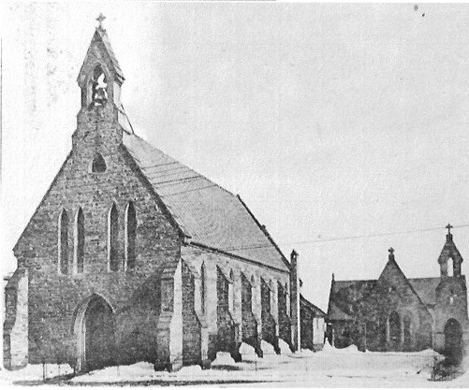 |
| Holy Innocents Church, Albany, New York |
A Tale of Two Churches
The Church of St. James the Less in Scarsdale and the Church of the Holy Innocents in Albany have remarkably similar origins. At the moment their buildings are experiencing quite divergent fates.
Both churches were designed by the British-born architect Frank Wills (1822-1857) who specialized in the design of early Gothic Revival churches and founded an architectural firm in NYC in 1847. He designed the Church of the Holy Innocents in 1848 and the Church of St. James the Less in 1851. The stained glass windows of Holy Innocents, still mostly in place, were inspired by William Jay Bolton (1816- 1884), also English born, who started a small stained glass shop in Pelham in 1842 and proceeded to produce the first figural stained glass in the USA. The windows at Holy Innocents and at SJTL were produced by Bolton’s younger brother John (1818-1898). The windows of SJL were de- stroyed in the 1882 Palm Sunday fire.
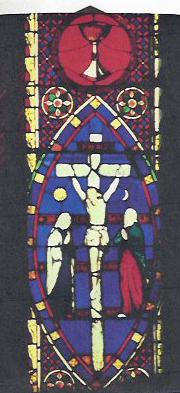 |
| Stained Glass window in Holy Innocents |
The Church of St. James the Less, rebuilt from its original walls and en- larged several times, continues to thrive. The Church of the Holy Inno- cents merged with Grace Church in 1956 and the older building was sold. It has been on the State and National Historic Registers since 1978 and was well maintained until 1997 when the Hope House Drug Rehab pur- chased it. Since then, it has suffered “demolition through neglect� to the point where, on May 2nd, 2015, the stone chancel arch suddenly collapsed and in turn destroyed one of the stained glass windows.
There is some enthusiasm for stabilizing the building, raising money for restoration, acquiring the building from the drug rehab people and fully restoring the old church, plus its circa 1880 Parish Hall, and converting them into a high grade day care center and perhaps pre K to be made available for the large number of low income working families that now oc- cupy a large portion of the surrounding neighborhood. The original name could be used to continue to remind people to seek better care and protec- tion of all children everywhere.
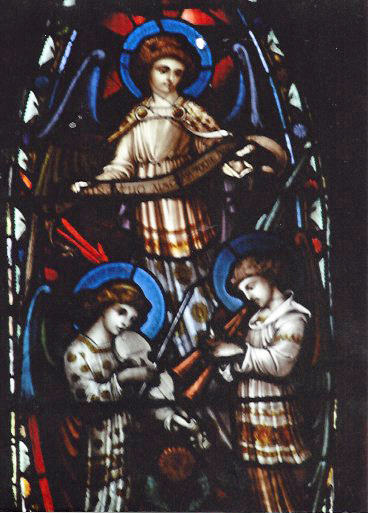 |
| Stained Glass window in Holy Innocents |
This former church is the only known extant building which still combines the work of the two artists, Frank Wills and John Bolton, in one space. IT IS IN IMMINENT DANGER OF BEING DEMOLISHED!
If the idea of preserving it for a use such as described above appeals to you, please express your views to the Honorable Kathy Sheehan, Mayor of Albany (mayor@albany.gov)
In the meantime, I plan to make an attempt to gain permission to visit the building and make photographs for the purpose of comparing it to our original structure.
Louise Clark
Note: Much of the information in this article was supplied by John Wolcott who wrote to SJL because of the obvious connections between the two churches.
Published in the newsletter of the Episcopal Church of St. James the Less, Scarsdale, New York.
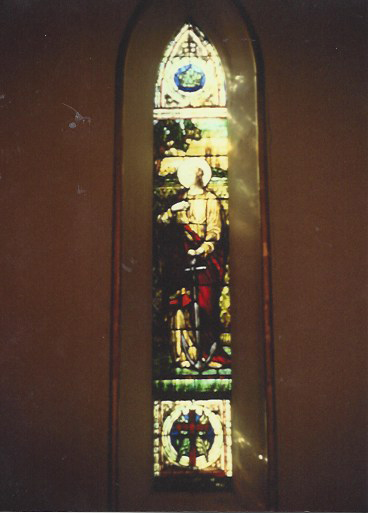 |
| Stained Glass window in Holy Innocents |
Section of former Church of Holy Innocents collapses
Albany demands immediate plan to stabilize historic Arbor Hill structure
By Jordan Carleo-Evangelist, Times Union, Tuesday, May 5, 2015
Albany: A section of the long-shuttered former Church of Holy Innocents in Arbor Hill collapsed Monday.
Responding to a phone call at 12:35 p.m., city firefighters arrived to find that the back southwest corner and adjacent roof of the stone masonry church near Livingston Avenue was a pile of rubble.
The area around the site was secured with a temporary fence. Traffic on the church side of North Pearl Street was closed off to protect people in the event of a collapse in the front of the building, across the street from the Ida Yarbrough Homes.
The landmark at 275 N. Pearl St. dates to 1850 and is owned by Hope House Inc., a residential recovery program next door.
The city issued a “notice and order” to Hope House requiring a plan to stabilize the building within 24 hours. “It is important that Hope House does everything possible is preserve this church, which has been recognized nationally as a historic treasure,” said Mayor Kathy Sheehan.
The Episcopal Church was designed in 1850 by architect Frank Wills. In 1866, a chapel was built by lumber baron William DeWitt as a memorial to his children. It was designed by architects William L. Woollett and Edward Ogden.
The church is on the National Registry of Historic Places, and Historic Albany Foundation added it to its list of Albany’s most endangered buildings 10 years ago. On Monday, even the boards on the windows were old and vine-covered.
Historic Albany Executive Director Susan Holland said there was already damage to the back corner that collapsed.
“It’s been getting worse every year,” she said, but added that it is still fixable.
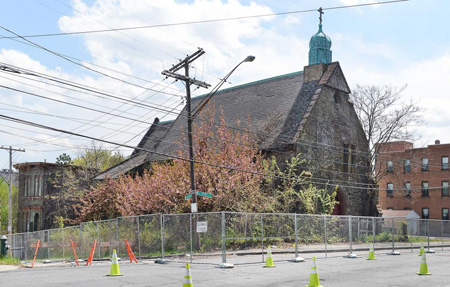 |
| The long-shuttered former Church of the Holy Innocents in Arbor Hill is fenced off after part of it collapsed Monday on N. Pearl Street Tuesday May 5, 2015 in Albany, NY. (John Carl D’Annibale / Times Union) |
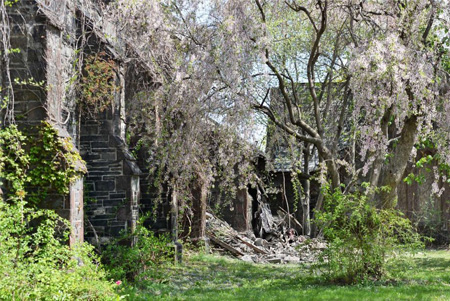 |
| Photo: John Carl D’Annibale The back southwest corner and adjacent roof of the long-shuttered former Church of Holy Innocents in Arbor Hill is a pile of rubble after a collapse Monday on N. Pearl Street Tuesday May 5, 2015 in Albany, NY. (John Carl D’Annibale / Times Union) |
An opportunity to save the former Church of the Holy Innocents
From Albany Archives, November 3, 2015
Historic Albany has been working with multiple partners to help save the former Church of the Holy Innocents, a unique and precious historic resource in the City of Albany. The church, which is located at 275 North Pearl Street in the Arbor Hill Neighborhood, was designed by Frank Wills, author of Ancient Ecclesiastical Architecture and its Principles, Applied to the Wants of the Church of the Present Day ©1850 and the godfather of modern Gothic Revival, ecclesiastical architecture. Built in 1850, Holy Innocents, which is described in his book, remains an important example of Wills’ work as well as the work of other craftsmen of the day, such as the Bolton brothers, who designed and created the church’s stained glass.
After more than a decade of advocating for its preservation, Historic Albany is now collaborating with HH Funding Corp., a subsidiary of Hope House and the current owner, and the City of Albany to stabilize and market this building for sale. In early May 2015, a portion of the south-facing wall of the church nave collapsed at a roof parapet and buttress. The church is now in urgent need of stabilization along with temporary weatherization to make it watertight before the winter season and to allow for its future restoration and use.
All parties decided that an intensive real estate campaign is needed to sell the property. The current real estate listing offers both the North Pearl Street church and the adjacent historic building on Colonie Street for one dollar (although the listing is for $1,000, which was required for some of the websites). The Church is individually listed on the National Register of Historic Places and is thus eligible for rehabilitation tax credits and/or grants. Redeveloped, this property stands at the gateway between the Ten Broeck Triangle and Downtown Theatre district and the burgeoning Warehouse District: http://www.loopnet.com/Listing/19479588/275-North-Pearl-Street-Albany-NY/.
In preparation for the necessary stabilization efforts, Historic Albany has solicited estimates for engineering construction documents. HH Funding Corp. has offered to transfer ownership of the property and buildings to a qualified new owner for one dollar. The new owner must demonstrate the financial resources necessary to undertake stabilization and meet the City of Albany’s requirements. If a qualified buyer comes forward soon, HH Funding Corp is willing to contribute to the cost of buttoning up the structure for the winter to help prevent further deterioration. The City of Albany has already contributed to this effort by waiving a portion of the Vacant Building Registration fees contingent upon Hope House’s continuing efforts to stabilize the building.
Historic Albany has also been in discussion with the collateral descendants of William H. DeWitt, the church’s original donor, who named the church in memory of his four children, none of whom lived to adulthood. Additionally, Partners for Sacred Sites, Preservation League of New York State and the New York State Office of Parks, Recreation and Historic Preservation have been working on this effort. Historic Albany Foundation support will continue with the transfer of property in order to help new owner secure professional engineering and contracting services, funding and agencies approvals.
As mentioned, the church will be aggressively marketed for sale and is eligible for Federal and NYS Rehabilitation tax credits among other historic preservation funding and redevelopment sources. There will be opportunities for public donations for the cause of saving the building and Historic Albany will be providing updates.
By working together with all the stakeholders and keeping the public educated, we stand a very good chance of saving this architecture gem for future generations. Your support and interest allows us to save another piece of Albany’s historic fabric!
Seriously Endangered Church of The Holy Innocents
May 5, 2015
In 1850, Albany lumber baron William H. DeWitt built a memorial to four of his children who died quite young. In addition to a splendid marble tombstone in the Albany Rural Cemetery, DeWitt also erected a little stone church in their memory; the Church of the Holy Innocents.
Built at the corner of North Pearl and Colonie Streets, it was a short walk from the DeWitt home to the church which was designed by Frank Wills. In the 1860s, a matching chapel was added to the south side; this addition designed by Edward Ogden and William L. Woolett.
Holy Innocents served as an Episcopal church until the late 1940s. Until 1980, it was home to a Russian Orthodox congregation (hence the distinctive blue “onion dome” which replaced the original steeple and bell around 1960.
Vacant since 1980 and currently owned by Hope House, this beautiful building has suffered greatly from neglect. It is listed on the National Register of Historic Places and cited by the Historic Albany Foundation as one of the city’s most endangered buildings, it is also one of the oldest church structures in Albany
Yesterday, the rear wall of the church collapsed. Despite the damage and the decades of neglect, Historic Albany Foundation states that the building can be stabilized and saved.
Albany is one of the oldest and most historic cities in the United States, but much of our tangible history has been lost to neglect and demolition. Several years ago, the equally historic Trinity Church was demolished after part of the structure caved in.
Please, let’s not lose the Church of The Holy Innocents, too. Call the City of Albany and let them know this historic church must be stabilized and saved, not reduced to yet another empty lot and yet another empty hole in the city’s cultural and historic fabric.
Office of The Mayor, City of Albany – 518-434-5100
Hope House (current owners of the site) – 518-482-4673 – Kevin Connally, Executive Director
Photos are from the Albany…The Way It Was collection on Flickr
article from blog by Paula Lemire
Here are the comments on the blog:
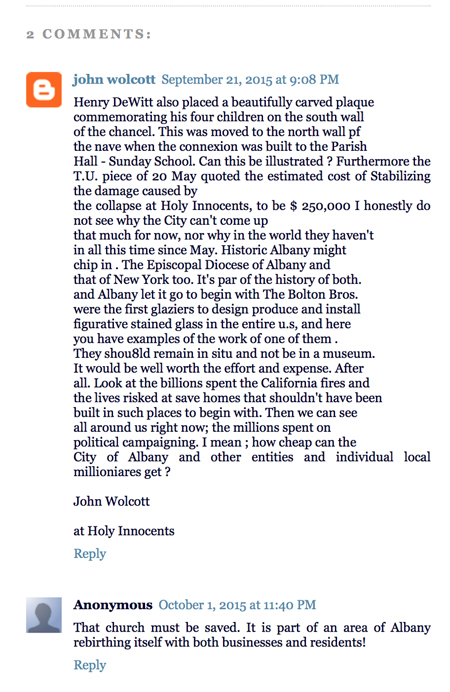
Letter to the editor, Times Union, July 21, 2015
The long-abandoned Church of the Holy Innocents in Albany bears certain, special details and particulars that make it a one-of-a-kind national treasure. It is, in fact, on the National Register of Historic Places yet lacks a sign to indicate that.
The city itself must save this treasure, no matter the cost. After all, the city is just about as guilty as others for the church’s ongoing deterioration since 1997. This has generally been by non-enforcement of building and historic sites codes.
It was reported in May that Albany Mayor Kathy Sheehan “called on Hope House to do ‘everything possible’ to save the church.” “Everything possible” leaves an opening for demolition as does concerns over costs.
Now there are those waving flags wonderfully while the dastardly destruction of a sacred site and a national treasure is being contemplated.
John Wolcott, Albany
Photos by John Wolcott
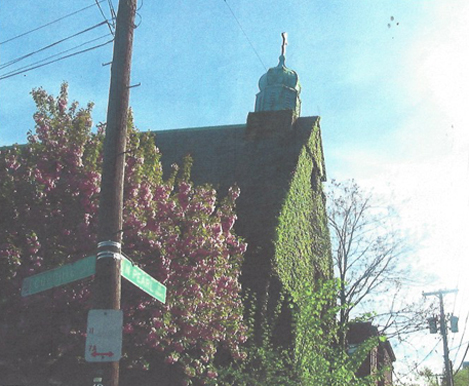 |
| Photos by John Wolcott of Holy Innocents in 2011 |
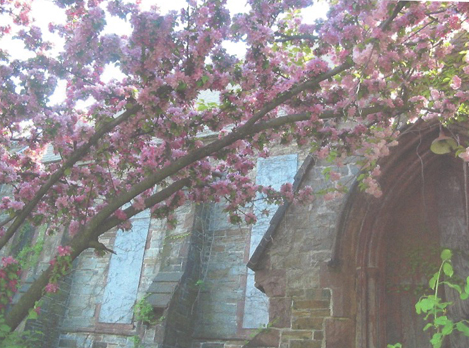 |
| Holy Innocents from Colonie Street |
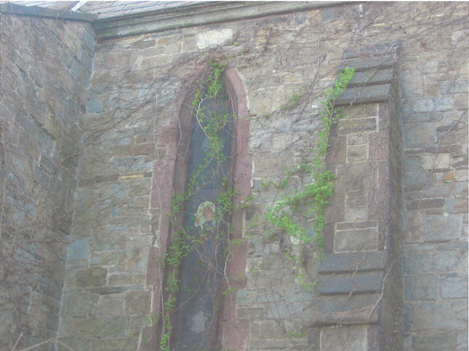 |
| Window on left is shown in photos above from the inside |
Fate of Albany’s historic Holy Innocents church unclear
Report says $1M needed to save deteriorated hulk
By Jordan Carleo-Evangelist, Times Union, Wednesday, May 20, 2015
Albany: Nearly three weeks after a section of the historic former Church of the Holy Innocents collapsed, the future of the ghostly 165-year-old Arbor Hill building remains murky.
An engineer hired by the owner, Hope House Inc., deemed it “structurally possible” to save the ivy-clad North Pearl Street structure but said it could cost as much as $250,000 just to stabilize and weatherproof it, Hope House Executive Director Kevin Connally said in an email.
A preliminary report by engineering firm Ryan Biggs Clark Davis last week said the cost to save the building “far exceeds the cost for total demolition and reconstruction” and could top $1 million before refurbishing the inside, Connally said.
Still, Mayor Kathy Sheehan has called on Hope House to do “everything possible” to save the church, and a loose working group that includes Historic Albany Foundation and the Albany Housing Authority is examining different opportunities to do just that. Sheehan’s chief of staff, Matthew Peter, has been coordinating what he described as “a very collaborative effort.â€�
Historic Albany Executive Director Susan Holland declined to divulge specifics, citing the tentative nature of the talks, but she acknowledged the estimates to repair the corner of the Gothic Revival church found to have collapsed May 4 were “a little more than we’d like to see.â€�
“We’re trying to work on the real nitty-gritty of it,” said Holland, whose organization a decade ago named the church among the city’s most endangered historic assets.
The fate of the city’s vacant and deteriorating 19th-century churches has become a sensitive issue in recent years in the wake of the 2011 collapse and demolition of Trinity Church in the South End and Historic Albany’s 2013 decision to hand St. Joseph’s Church in the Ten Broeck Triangle back over to the city after a decade of frustrated redevelopment attempts.
The Albany Housing Authority is involved in the discussions on saving Holy Innocents because it owns the Ida J. Yarbrough Homes directly across North Pearl Street.
AHA Executive Director Steven Longo said his agency eyed the church in 2012 — when it drafted plans for the $17.8 million first phase of redevelopment for the low-rise Ida Yarbrough apartments — as a potential community center or administrative building.
That project entails demolition of 76 existing apartments and replacing them with 61 new apartments and townhomes, with the help of $5.5 million from New York State Homes & Community Renewalannounced by Gov. Andrew Cuomo last week.
The numbers to include the church didn’t work as part of the residential development project back then, Longo said, but the housing authority is revisiting the possibility in the wake of the recent collapse.
“The church has been our neighbor for a very long time,” Longo said, “and we don’t want to see anything happen to it.”
Hope House, a nonprofit that runs substance abuse treatment programs, is headquartered on the same block between Livingston Avenue and Colonie Street. It bought the long-vacant property in the late 1990s with an eye toward using it as a recreational facility for the program’s residents, Connally said.
When the cost proved too high, he said, the group failed in efforts to find grants to save the church. No buyers would take it “at no cost.â€�
The T-shaped structure, built in 1850, is notable for stained-glass windows designed and built by artisan John Bolton that are touted as “fairly rare examples dating from the first phase of the American Gothic Revival,” according to a 1976 application for listing it on the National Register of Historic Places. It was listed in 1978.
A small chapel, connected by a stone passage way, was added in 1866, and the church much later became a Russian Orthodox house of worship with its distinctive cupola before going vacant.
“Hope House remains committed to working with the city of Albany to address this situation in the safest, most responsible manner, in full compliance with our legal obligations,” Connally said. “We sincerely appreciate the architectural importance of the building and its value to the neighborhood and are sensitive to the concerns of those who believe this part of Albany’s architectural history should be appropriately preserved. We remain grateful that no one was injured in the collapse and are committed to protecting the well-being of our community and our neighborhood.”
jcarleo-evangelist@timesunion.com • 518-454-5445
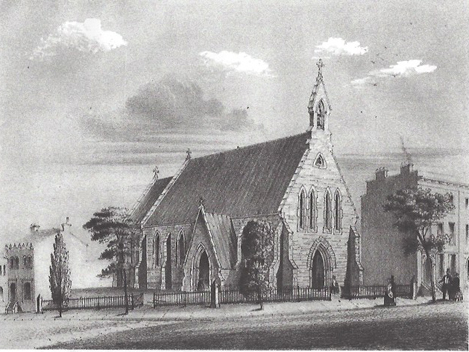 |
| Holy Innocents Albany 1849 Engraving 1850 After a Drawing by Frank Wills, The Architect of this Church |
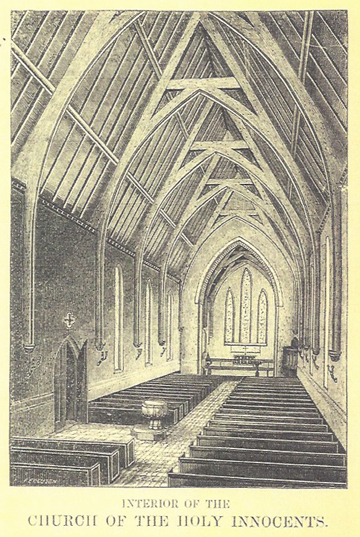 |
| Engraving published in Albany in 1859 |
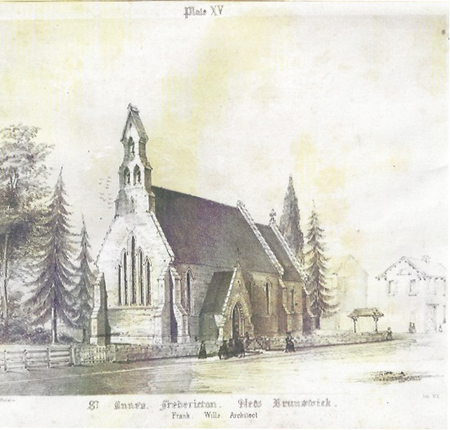 |
| Frank Wills went to Canada first in 1846. This is his first complete church in North America. |
Floor Plan of the Holy Innocents
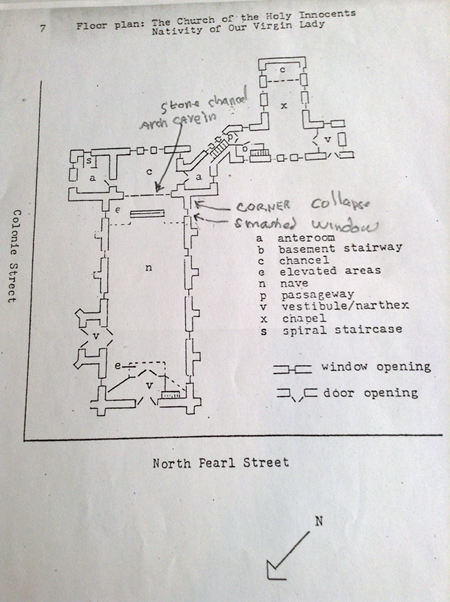 |
| Floor Plan of the Church of the Holy Innocents |